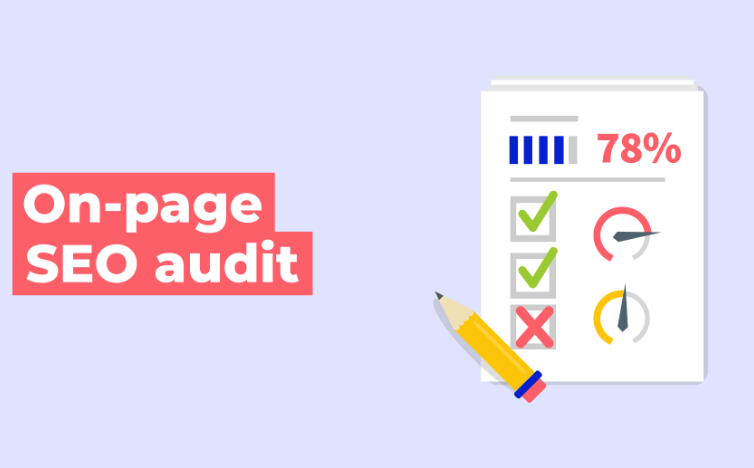Conducting an on-page SEO audit is crucial for improving your website’s visibility and ranking in search engines. By examining your website’s content, structure, and technical elements, you can identify areas for improvement. This guide will walk you through the essential steps to conduct a thorough on-page SEO audit.
On-Page SEO Audit for Better Rankings

1. Check Page Load Speed
Page speed is a critical factor that affects both user experience and search engine rankings. Use tools like Google PageSpeed Insights or GTMetrix to assess your website’s loading speed. Aim for a load time of under 3 seconds. Consider optimizing images, using browser caching, and minimizing JavaScript to improve speed.
2. Analyze URL Structure
URLs should be clean, concise, and include target keywords. Avoid complex strings and numbers in your URLs. Each page’s URL should be descriptive of its content to provide clarity for both users and search engines. A proper URL structure can improve click-through rates and ranking potential.
3. Examine Title Tags and Meta Descriptions
Title tags and meta descriptions play a key role in SEO. Make sure each page has a unique title tag that includes your primary keyword and stays under 60 characters. Meta descriptions should be engaging and under 160 characters, containing relevant keywords to encourage users to click.
4. Optimize Header Tags (H1, H2, H3)
Header tags (H1, H2, H3) help organize content and signal its importance to search engines. Each page should have a single H1 tag with your main keyword, followed by subheadings using H2 and H3 tags to structure the content logically. Ensure that keywords are used naturally in headers.
5. Evaluate Content Quality and Relevance
High-quality, relevant content is essential for on-page SEO. Check if the content aligns with user intent and includes target keywords naturally. Avoid keyword stuffing and focus on creating informative and engaging content. Make sure your content is unique and adds value to the reader.
6. Check Internal Linking Structure
Internal links help search engines understand the structure of your website and distribute link equity. Review your internal linking strategy to ensure relevant pages are connected. Use anchor text with keywords, but avoid over-optimizing. Aim for a natural linking pattern to guide users.
7. Optimize Images and Alt Text
Images should be optimized to improve page load speed and SEO. Use compressed formats like JPEG or WebP, and include descriptive file names with keywords. Add alt text to each image, providing a brief and keyword-rich description to assist search engines in understanding the image content.
See Also: Boost Your Google Rankings with Effective On-Page SEO
8. Review Mobile Friendliness
Mobile optimization is crucial since most users browse on mobile devices. Use Google’s Mobile-Friendly Test to evaluate if your website is responsive. Ensure all pages adapt well to different screen sizes, and buttons are easily clickable. Improving mobile usability can enhance user experience and boost rankings.
9. Examine Content Readability
Content should be easy to read for a wide audience. Use short paragraphs, bullet points, and simple language. Consider tools like Hemingway or Grammarly to evaluate readability. Content that is accessible and well-structured will increase user engagement and reduce bounce rates.
10. Audit Technical SEO Elements
Technical SEO is foundational to a successful on-page audit. Check for issues like broken links, duplicate content, and missing tags. Use tools like Screaming Frog or Ahrefs to identify and fix technical errors. Pay attention to canonical tags, robot.txt files, and XML sitemaps for better crawling and indexing.
See Also: Technical SEO Tips to Boost Your Website Performance
11. Use Schema Markup for Rich Snippets
Schema markup helps search engines understand your content better, potentially leading to rich snippets in search results. Implement structured data like FAQ, product, and review schema where relevant. Tools like Google’s Structured Data Testing Tool can verify proper implementation.
12. Analyze User Engagement Metrics
Review user engagement metrics like bounce rate, average session duration, and pages per session using tools like Google Analytics. These indicators can provide insights into how well your content engages users. Use the data to identify underperforming pages and make necessary adjustments.
13. Monitor and Adjust for Continuous Improvement
SEO is an ongoing process. After making adjustments based on your audit, monitor the results and continue to tweak your strategy. Keep an eye on ranking changes, traffic, and user behavior. Regular audits can help maintain and improve your SEO performance over time.
Call us: Contact us For SEO Services: +971 58 830 3415
By following these steps, you can ensure that your website is fully optimized for search engines, providing better visibility, improved rankings, and an enhanced user experience. Keep auditing regularly to stay ahead of SEO trends and algorithm changes.
